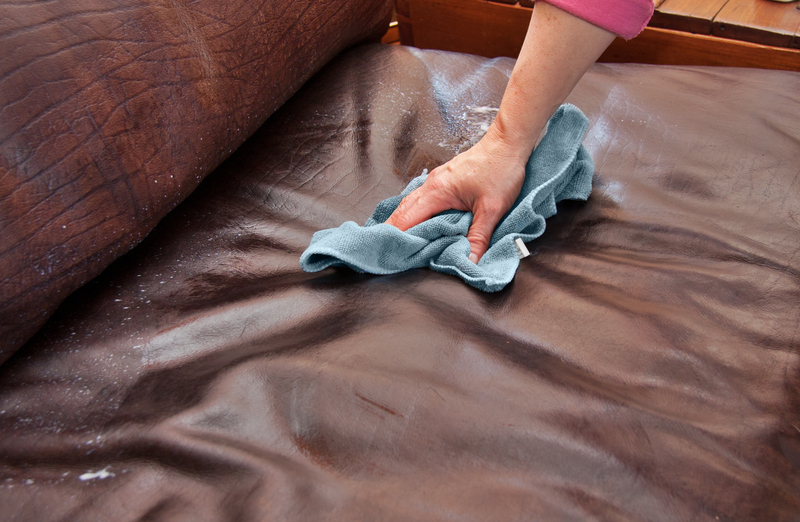Elevate Your Space: Essential Curtain Cleaning Techniques
Posted on 06/09/2025
Elevate Your Space: Essential Curtain Cleaning Techniques
Transforming your home starts with the little things--like the care and cleanliness of your curtains. Often overlooked, curtains serve more than just a decorative purpose; they play a key role in improving indoor air quality and determining your room's ambiance. If you wish to breathe new life into your living spaces, mastering essential curtain cleaning techniques is a must.
This comprehensive guide explores curtain cleaning methods, from routine maintenance to tackling tough stains. Whether you own luxurious drapes or simple sheers, the following techniques and expert tips will help you preserve your curtains' beauty and elevate your space--making your home a healthier, more inviting haven.
Why Curtain Cleaning Matters for Your Home's Aesthetics and Health
Clean curtains can make or break your room's style. But there's more to immaculate window treatments than what meets the eye:
- Air Quality: Curtains attract dust, pollen, pet dander, and airborne pollutants. Regular cleaning helps prevent allergy flare-ups and ensures fresher indoor air.
- Longevity: Dirt and dust act like sandpaper, wearing down fibers over time. Keeping your curtains clean extends their lifespan and saves you money in the long run.
- Ambiance: Clean, vibrant curtains brighten up any room, whereas stained, dingy drapes create a dull and cluttered appearance.
- Odor Control: Curtains can absorb odors from cooking, smoking, and pets. Proper curtain cleaning techniques help eliminate unwanted smells.
Now that you know why it's important, let's explore essential curtain cleaning techniques to elevate your living space effectively.

Step-By-Step: Curtain Cleaning Techniques for Every Material
Not all curtains are created equal. From sheer fabrics to heavy velvet drapes, different materials require unique care. Below we break down the best approaches for cleaning various curtain types.
1. Read the Care Label First
Always start by checking the manufacturer's label. This vital step will help you avoid irreversible damage. Labels typically provide washing instructions and cleaning restrictions based on the fabric's delicacy and colorfastness.
2. Routine Curtain Maintenance
Regular maintenance is the simplest way to keep your curtains looking their best between deep cleans:
- Weekly Dusting: Use a vacuum cleaner with a soft brush attachment or a lint roller to remove dust and pet hair.
- Monthly Shaking: Take your curtains down and give them a good shake outside to dislodge dirt and debris.
- Spot Cleaning: Immediately attend to spills and stains with a damp cloth and mild detergent appropriate for the fabric type.
Routine maintenance prevents dust from settling in, helping maintain a fresh and welcoming atmosphere.
Deep Cleaning Curtain Methods: Washing, Steaming, and Dry Cleaning
Hand Washing Curtains
Hand washing is best for delicate materials that may be damaged by machine agitation. Follow these steps:
- Fill a tub with lukewarm water and a mild detergent.
- Soak the curtains for 10-15 minutes to loosen dirt.
- Gently agitate the fabric, paying close attention to stains or heavily soiled areas.
- Rinse thoroughly to remove all soap residues.
- Press out excess water without wringing, then hang to dry.
Machine Washing Curtains
Many modern curtains are machine-washable, but always use a gentle cycle and cool water. To avoid damage:
- Remove all hooks, rings, or removable hardware.
- Wash with mild liquid detergent--avoid bleach, which can weaken fibers and fade colors.
- Wash with similar colors and light clothing items for even washing.
- After washing, hang curtains while still damp to minimize wrinkling.
Tip: If your curtains have a lining, check if it's also machine-washable; sometimes, linings require separate care.
Steam Cleaning Curtains
Steaming is a powerful and convenient curtain cleaning technique, especially for heavy drapes you prefer not to remove from the rod.
- Start at the top and work your way down to allow gravity to help release dust.
- Keep the steam cleaner at a safe distance to avoid soaking the fabric.
- Let the curtains air-dry with ample ventilation to prevent mold.
Steam cleaning is especially effective for killing mites and bacteria, making it ideal for households with allergies.
Dry Cleaning Curtains
For delicate curtains with intricate detailing or made from materials like velvet, silk, or wool, professional dry cleaning is recommended. If the label reads "dry clean only," avoid DIY washing to prevent:
- Shrinking, warping, or discoloration
- Fabric deterioration
- Loss of special finishes or treatments, such as blackout lining or flame resistance
Take note: Always inform your dry cleaner about any stains and the curtain's specific material for optimal results.
Spot Cleaning: Handling Stubborn Stains and Odors
A spill on your beautiful drapes doesn't have to spell disaster. The key is prompt, careful treatment:
- BLOT (do not rub) the affected area with a clean, absorbent cloth to remove excess liquid.
- Mix a mild stain remover using a few drops of gentle detergent in warm water.
- Dab the stain using a sponge or soft cloth, working from the outside in to prevent spreading.
- Finish with fresh water, rinsing gently and blotting dry.
- Repeat for tough stains like wine, coffee, or ink--but test a small, hidden spot first to ensure colorfastness.
Odors can also be minimized by lightly misting curtains with a fabric-safe deodorizer or a diluted vinegar solution (1 part vinegar to 4 parts water). Always ventilate the area thoroughly.
How to Clean Different Curtain Types (Fabric-Specific Tips)
Sheer Curtains
Sheer and voile curtains are lightweight and prone to snagging, so treat them with extra care:
- Hand wash or machine wash alone in a delicate cycle with a mesh laundry bag.
- Avoid wringing--press between towels to absorb excess water.
- Air-dry away from direct sunlight, which can cause yellowing.
Cotton Curtains
Most cotton curtains are easy to machine-wash and maintain:
- Use cool water and a mild detergent.
- Line dry to prevent shrinking, or tumble dry on low if recommended by the manufacturer.
- Iron on a low setting if necessary.
Velvet and Heavy Drapes
Thick, luxurious fabrics like velvet or brocade require extra attention:
- Vacuum using a brush attachment to remove dust and debris between cleanings.
- Steam clean while hanging to refresh the fabric and remove creases.
- For deep cleaning, always opt for professional dry cleaning.
Thermal and Blackout Curtains
Specialty curtains with insulating layers or coatings often require gentle handling:
- Spot clean stains with a cloth and mild soap; avoid soaking the thermal backing.
- If labeled as washable, use cold water and a delicate cycle.
- Naturally air dry--never use heat, which can damage insulation and coatings.
Shower Curtains (Vinyl and Fabric)
Even shower curtains play a big part in home hygiene:
- Plastic or vinyl curtains can be wiped down with diluted vinegar and water to prevent mildew.
- Fabric shower curtains are usually machine-washable; add baking soda to boost cleaning power.
General Curtain Cleaning Tips for All Households
Regardless of material, these universal tips will maximize your curtain cleaning efforts:
- Clean curtains at least twice a year for best results; more frequently in smoky, dusty, or high-traffic homes.
- Open windows regularly to promote ventilation and reduce the buildup of moisture and odors.
- Use essential oils or fabric sprays for a subtle, pleasant fragrance.
- Avoid direct sunlight when drying or hanging curtains for long periods--prolonged exposure can cause colors to fade.
- Whenever possible, air out your curtains outdoors to refresh their fibers naturally.
Expert Tips: Protecting Your Curtains for the Long Haul
Want your curtains to look like new year after year? Try these professional secrets:
- Rotate and Rehang: Occasionally switch curtain positions to even out exposure to sunlight and air.
- Line Your Curtains: Add a liner to protect delicate fabrics from damage and dust.
- Store with Care: If you swap out curtains seasonally, store them in a cool, dry place in a breathable cotton bag--not plastic.
- Prevent Mold and Mildew: Use a dehumidifier and keep curtains slightly off the floor in damp or humid environments.
Investing in minor preventive measures will extend the life of your curtains and keep your space fresh.

FAQs: Curtain Cleaning Techniques
- How often should I clean my curtains?
Ideally, deep clean curtains every 6 months and perform routine dusting or vacuuming weekly. - Can I machine-wash all curtains?
No. Always check the care label. Certain fabrics (like velvet or silk) should only be dry cleaned. - Is steam cleaning safe for all curtains?
While safe for most synthetic or thick curtains, always test a small area first, especially with delicate fabrics. - What is the best way to remove pet hair from curtains?
A vacuum cleaner with a brush attachment or a lint roller are both effective for removing pet hair. - Can curtain cleaning help reduce allergies at home?
Absolutely! Regularly cleaning your curtains reduces dust, pollen, and pet dander, improving air quality.
Conclusion: Transform Your Home with Expert Curtain Cleaning
Don't underestimate the transformative power of clean, beautiful curtains. With the curtain cleaning techniques discussed above, you'll not only enhance your space visually, but also reap the health benefits of a cleaner indoor environment.
Make curtain cleaning a regular part of your home care routine--your windows, your family, and your guests will all appreciate the difference. Take your space to the next level by elevating your curtains' care today!



